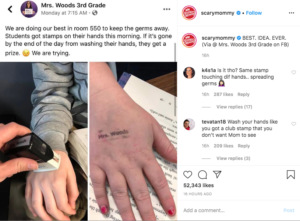As COVID-19 continues to generate headlines, schools are working to keep students and staff safe while informing their communities about the potential impacts on learning.
The OCDE Newsroom has been providing the latest relevant information from local, state and federal agencies with our running digest of coronavirus updates. Meanwhile, we’ve also compiled some tips to help teachers promote healthy habits and decrease anxiety in their classrooms.
Some of these were created using the recently released California Department of Public Health guidelines for schools. Others were pieced together from news media reports that featured doctors and other health care experts.
Review hand-washing techniques with students.
Experts continue to promote hand-washing as one of the most effective ways to stave off illnesses. But you can teach kids how long to scrub their hands by singing a 20- to 30-second song together.
“Happy Birthday” or the “ABCs” are classics. You can also be creative and sing 20- to 30-second versions of any song the child likes. A teacher on social media posted her idea for making sure her students wash their hands throughout the day. Check it out below.
Discourage the sharing of food.
Children often enjoy trading snacks, like scoring some Doritos from a classmate in exchange for carrot sticks. But these trades can also involve the exchanging of germs from one child to another. So it might be best for every student to just stick to their own lunches and snacks, according to experts.
Perform routine environmental cleaning.
Routinely clean frequently touched surfaces — like doorknobs, light switches and desktops — with the cleaners approved for school use. Use all cleaning products according to the directions on the label. Provide disposable wipes so commonly used surfaces such as keyboards, desks and remote controls can be wiped down by students and staff before each use.
Help children cope with anxiety.
It’s important to validate students’ feelings, especially when they’re worried or anxious, says child psychologist Laura Saunders. There’s been a lot of information on the news, and adults around them might be talking about the subject, so it’s understandable that some children might have concerns. Teachers should avoid being dismissive. Instead, they should encourage students to be open about how they’re feeling, Saunders said.
Remember that kids make mistakes. If your student accidentally does not wash their hands or doesn’t sneeze into their elbow, gently remind them. Scaring children with the potential consequences of their mistakes can be detrimental. It’s important to remind children that we are all trying our best to stay healthy and it’s not anyone’s fault if they do get sick.
Discourage stigmatization of any students or populations.
Teachers can help children understand that the coronavirus can impact all races, nationalities and socioeconomic groups the same. Even if the threat originated in one region, no group of people is more or less susceptible to catching or carrying the illness.
Use this as a teaching moment.
For older students, especially those in high school, teachers can use the coronavirus threat as a teachable experience.
Science teachers can encourage students to look at the outbreak through the scientific lens, tracking how communicable diseases originate and spread. Health teachers can emphasize healthy habits students should follow in general. And other teachers can have students curate news articles, social media posts and other content so they can learn to better identify legitimate information from fake news.
For younger students, teachers can remind them that doctors and other experts around the world are working hard to stop the virus. This can help kids understand that smart, capable people are taking action.
Are you a local teacher with other tips we can add? Send us a note at communications@ocde.us, or reach out to us on Facebook, Twitter or Instagram.

